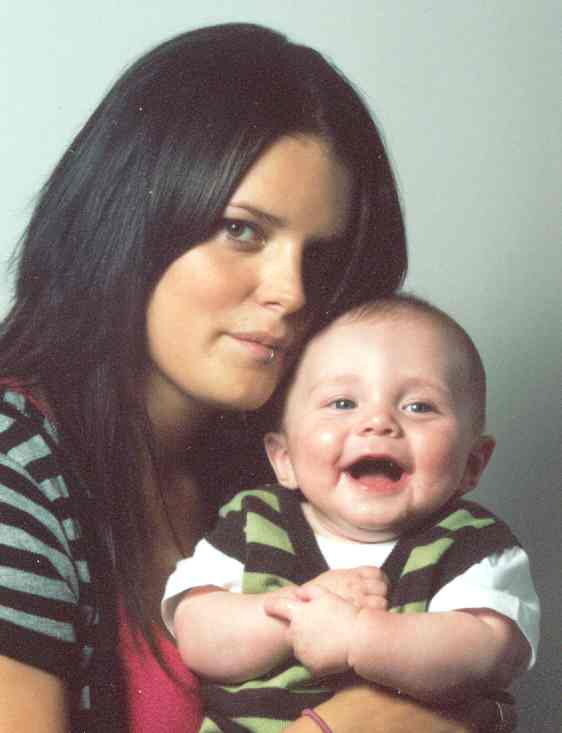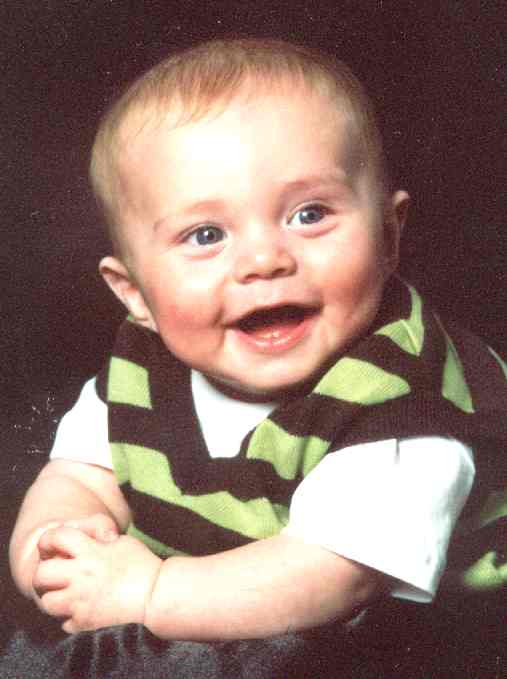|
KYLA and HAIDEN
|
||||||||||||||||||||||||||||||||||||||||||||||
|
HOME | BIOLOGY | FILMS | GEOGRAPHY | HISTORY | INDEX | INVESTORS | MUSIC | NEWS | SOLAR BOATS | SPORT |
||||||||||||||||||||||||||||||||||||||||||||||
Motherhood is something very special. But what does it mean to a woman? Let's take a look at one very lucky mother in Sussex.
According to Kyla, seen below with he son of six months, it was a life changing experience:-
Kyla and Haiden
When Kyla discovered she was pregnant (she didn't find out until 3 months into the pregnancy) at first she was shocked and didn't know what to do next, but quite soon she had to make the decision which would change her life completely - should she keep the baby or not? In days gone by mothers to be did not have a choice - but thanks to modern advances in medicine - there is.
Obviously, from the pictures below, Kyla discovered that her desire to be a mother outweighed all other considerations. The rest is history.
THE PREGNANCY
The pregnancy was filled with its fair share of surprises. Kyla suffered morning sickness and became anemic. As far as we know there is no cure for morning sickness - her doctor said that in the morning she should eat ginger biscuits. In fact we find this to be useful advice for a whole raft of ailments.
Iron tablets provided some recovery from her anemic condition, but not totally, and in fact Kyla is still partially anemic, leaving her feeling weak and feint sometimes.
THE BIRTH
The pregnancy ran 10 days overdue. For this reason Kyla elected to be induced, simply because the mother could not handle the mental and physical strains. She just couldn't wait.
The birth itself was not painful, but this is because Kyla had an epidural and was unconscious during the birth. Kyla was assisted during the delivery by two midwives and her mother - lucky girl. At first the team tried a vacuum extractor called a ventouse (see below), a cap that goes over the infant's head, then when this didn't work, resorted to forceps. Haiden was finally born at 6 minutes to 6 on the 5th of April 2006, he is now 6 months old.
POST NATAL
Kyla was exceptionally fortunate not to suffer depression, but she did suffer septicemia which lasted a week and she ended up back in the Eastbourne District General Hospital fighting for her life, admitted through the A and E at 4:00am in the morning, with lower abdominal pains and a fever. Kyla flat-lined at this time, but we're pleased to say she pulled through to a full recovery.
Haiden at six months
DELIVERY TECHNIQUES
Until very recently, most British hospitals used forceps far more frequently than ventouse, but the balance between the two methods is now shifting and if you have a preference for one over the other, you may be able to choose.
Forceps
Before they can be put round the babyís head, the doctor needs to enlarge the opening from the vagina by cutting through the back wall into the perineum (the tissue between the back of the vagina and the rectum). If you have an epidural in place, you wonít feel the cut. If you havenít, your midwife or doctor will inject some local anaesthetic into the perineum before making the cut.
The forceps come in two sections and the doctor gently places the first blade round the side of your babyís head, and then the second blade round the other side. There is a mechanism to fix the forceps once they have been correctly placed so that they donít slip. You are asked to push with your next contraction and the doctor pulls. You deliver the baby together.
After the birth
As soon as your baby is born, the forceps will be removed and the paediatrician will check the baby over. As long as your baby is in good health, he will be brought back to you immediately.
Risks to the baby
In general, babies born by forceps are fine. However there are, inevitably, some risks attached to bringing babies into the world in this way:
Ventouse
It takes about seven minutes to apply enough suction to ensure that the cap is firmly attached. The doctor then pulls on the ventouse while the mother pushes in order to help the baby to be born.
After the birth
The procedure is the same as for forceps. The cap is removed from the babyís head and, once the baby has been given the all clear by the paediatrician, he is quickly given back to his mother.
Risks
Forceps
Ventouse
Research suggests that for women, a ventouse delivery is a much gentler option than forceps. For babies, it doesnít seem to make much difference - both forceps and ventouse deliveries carry small risks.
SEPTICEMIA DEFINITION:
Septicemia is the presence of bacteria in the blood ( bacteremia ) and is often associated with severe disease.
Alternative Names: Blood poisoning; Bacteremia with sepsis
Causes, incidence, and risk factors:
Septicemia is a serious, life-threatening infection that gets worse very quickly. It can arise from infections throughout the body, including infections in the lungs, abdomen, and urinary tract. It may come before or at the same time as infections of the bone ( osteomyelitis ), central nervous system ( meningitis ), or other tissues.
Septicemia can rapidly lead to septic shock and death. Septicemia associated with some organisms (germs) such as meningococci can lead to shock , adrenal collapse, and disseminated intravascular coagulopathy , a condition called Waterhouse-Friderichsen syndrome .
Septicemia can begin with spiking fevers and chills, rapid breathing and heart rate, the outward appearance of being seriously ill (toxic) and a feeling of impending doom. These symptoms rapidly progress to shock with decreased body temperature (hypothermia), falling blood pressure, confusion or other changes in mental status, and blood-clotting abnormalities evidenced by a specific type of red spots on the skin (petechiae and ecchymosis).
LINKS
HUMANS:
A taste for adventure capitalists
Solar Cola - the healthier cola alternative
|
||||||||||||||||||||||||||||||||||||||||||||||
|
This
website
is Copyright © 1999 & 2012 NJK.
The bird |
||||||||||||||||||||||||||||||||||||||||||||||
|
AUTOMOTIVE | BLUEBIRD | ELECTRIC CARS | ELECTRIC CYCLES | SOLAR CARS |

